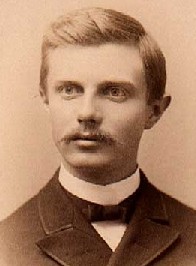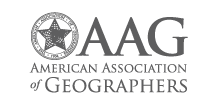
A geographer is a physical scientist, social scientist or humanist whose area of study is geography, the study of Earth's natural environment and human society, including how society and nature interacts. The Greek prefix "geo" means "earth" and the Greek suffix, "graphy", meaning "description", so a geographer is someone who studies the earth. The word "geography" is a Middle French word that is believed to have been first used in 1540.

U.S. Route 66 or U.S. Highway 66 was one of the original highways in the United States Numbered Highway System. It was established on November 11, 1926, with road signs erected the following year. The highway, which became one of the most famous roads in the United States, ran from Chicago, Illinois, through Missouri, Kansas, Oklahoma, Texas, New Mexico, and Arizona before terminating in Santa Monica in Los Angeles County, California, covering a total of 2,448 miles (3,940 km).

Frederick Jackson Turner was an American historian during the early 20th century, based at the University of Wisconsin-Madison until 1910, and then Harvard University. He was known primarily for his frontier thesis. He trained many PhDs who went on to become well-known historians. He promoted interdisciplinary and quantitative methods, often with an emphasis on the Midwestern United States.

Citgo Petroleum Corporation, or Citgo, is a United States–based refiner, transporter and marketer of transportation fuels, lubricants, petrochemicals and other industrial products. Headquartered in the Energy Corridor area of Houston, it is majority-owned by PDVSA, a state-owned company of the Venezuelan government.

The Rose Fitzgerald Kennedy Greenway is a linear park located in several Downtown Boston neighborhoods. It consists of landscaped gardens, promenades, plazas, fountains, art, and specialty lighting systems that stretch over one mile through Chinatown, the Financial District, the Waterfront, and North End neighborhoods. Officially opened in October 2008, the 17-acre Greenway sits on land created from demolition of the John F. Fitzgerald Expressway as part of the Big Dig project.

Robert David Kaplan is an American author. His books are on politics, primarily foreign affairs, and travel. His work over three decades has appeared in The Atlantic, The Washington Post, The New York Times, The New Republic, The National Interest, Foreign Affairs and The Wall Street Journal, among other publications.

Arthur Asahel Shurcliff was an American landscape architect. After over 30 years of success as a practicing landscape architect and town planner, in 1928 he was called upon by John D. Rockefeller Jr., and the Boston architectural firm of Perry, Shaw & Hepburn to serve as Chief Landscape Architect for the restoration and recreation of the gardens, landscape, and town planning of Colonial Williamsburg, Virginia, a position he held until his retirement in 1941. It was the largest and most important commission of his career.

The Royal Canadian Geographical Society is a Canadian nonprofit educational organization. It has dedicated itself to spreading a broader knowledge and deeper appreciation of Canada, including its people, places, natural and cultural heritage, as well as its environmental, social and economic challenges.
John Brinckerhoff "Brinck" Jackson was a writer, publisher, instructor, and sketch artist in landscape design. Herbert Muschamp, architecture critic of the New York Times, stated that J. B. Jackson was "America's greatest living writer on the forces that have shaped the land this nation occupies." He was influential in broadening the perspective on the "vernacular" landscape.

The American Association of Geographers (AAG) is a non-profit scientific and educational society aimed at advancing the understanding, study, and importance of geography and related fields. Its headquarters is located in Washington, D.C. The organization was founded on December 29, 1904, in Philadelphia, as the Association of American Geographers, with the American Society of Professional Geographers later amalgamating into it in December 1948 in Madison, Wisconsin. As of 2020, the association has more than 10,000 members, from nearly 100 countries. AAG members are geographers and related professionals who work in the public, private, and academic sectors.

The Oxford History of the United States is an ongoing multivolume narrative history of the United States published by Oxford University Press. Conceived in the 1950s and launched in 1961 under the co-editorship of historians Richard Hofstadter and C. Vann Woodward, the series has been edited by David M. Kennedy since 1999.
Donald William Meinig was an American geographer. He was Maxwell Research Professor Emeritus of Geography at the Maxwell School of Citizenship and Public Affairs, Syracuse University.
Robert Arthur "Robin" Donkin, FBA was an English historian and geographer who served as a reader in historical geography in the University of Cambridge's Department of Geography in 1990. A fellow of the British Academy, Donkin published works on a wide range of subjects, including Cistercian monasteries, agricultural terracing, the history of pearls and pearl fishing, the Muscovy duck, the Guinea fowl, and the history of spices and aromatics.
Andrew Sluyter is an American social scientist who currently teaches as a professor in the Geography and Anthropology Department of the Louisiana State University in Baton Rouge. His interests are the environmental history and historical, cultural, and political ecology of the colonization of the Americas. He has made various contributions to the theorization of colonialism and landscape, the critique of neo-environmental determinism, to understanding pre-colonial and colonial agriculture and environmental change in Mexico, to revealing African contributions to establishing cattle ranching in the Americas, and to the historical geographies of Hispanics and Latinos in New Orleans. With the publication of Black Ranching Frontiers: African Cattle Herders of the Atlantic World, 1500–1900 and a 2012–13 Digital Innovation Fellowship from the American Council of Learned Societies, he has joined a growing number of scholars from multiple disciplines working from the perspective of Atlantic History and using the tools of the Digital Humanities. His latest book, Hispanic and Latino New Orleans: Immigration and Identity since the Eighteenth Century, co-authored with Case Watkins, James Chaney, and Annie M. Gibson, was awarded the 2015 John Brinckerhoff Jackson Book Prize by the American Association of Geographers.
Matthew Gandy, FBA is a geographer and urbanist. He is Professor of Cultural and Historical Geography and Fellow of King's College at the University of Cambridge, moving from University College London (UCL) in 2015, where he was also the founder and first Director of the UCL Urban Laboratory from 2005 to 2011.

Kilham & Hopkins was an architectural firm in Boston, Massachusetts formed in 1899 or 1900 by its founding members, Walter Harrington Kilham and James Cleveland Hopkins. The firm later became Kilham, Hopkins & Greeley after William Roger Greeley joined the firm in 1916, and Kilham Hopkins Greeley and Brodie after Walter S. (Steve) Brodie joined the firm in 1945.

Lawrence Allen Ruttman is an American attorney, author, and historian. He is best known for his two books of biographical cultural history, Voices of Brookline and American Jews and America's Game, and for his baseball memoir, My Eighty-Two Year Love Affair with Fenway Park: From Teddy Ballgame to Mookie Betts.
A Boston Landmark is a designation by the Boston Landmarks Commission for historic buildings and sites throughout the city of Boston based on the grounds that it has historical, social, cultural, architectural or aesthetic significance to New England or the United States. While National Landmark or National Register status can provide tax incentives for the owner of an income-producing property, local landmark status provides more control over modifications to a designated historic structure or place.

The Boston Citgo sign is a large, double-faced sign featuring the logo of the oil company Citgo that overlooks Kenmore Square in Boston. The sign was installed in 1940 and updated with Citgo's present logo in 1965. The sign has become a landmark of Boston through its appearance in the background of Boston Red Sox games at Fenway Park.
Mona Domosh is a geographer and academic, and currently holds the Joan P. and Edward J. Foley Jr. 1933 Professorship of Geography at Dartmouth College.












